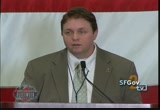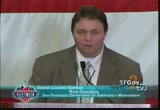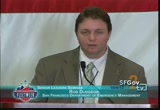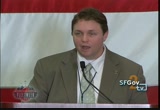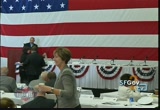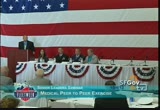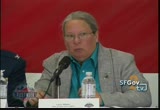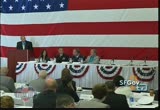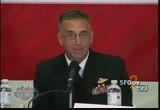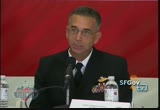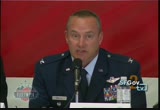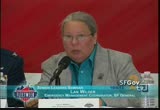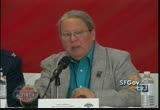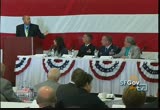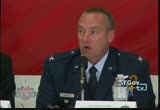tv [untitled] November 30, 2012 2:00am-2:30am PST
2:00 am
probably saying is, you know, maybe we should consider very severe environments in case of a disaster which personally i think that's how we train and probably most of your environments. maybe you want to start from a place of more limitations rather than less and one of them is not doing that kind of coordination via cell phone. again, i think this was, last year there was a table top, this is the first time we're actually doing a drill. there's reason for growth and as bijon said, maybe next year we are meshing xhapld and control so command and control is done over the exercise com link and keeping it separate. i think the point is well taken that the recommendation i made, i think we can introduce more rigor into the execution of the com drills next year.
2:01 am
>> any other questions? panelists, thank you very much, i appreciate it. let's give them a big round of applause. (applause). >> something that took place yesterday was our medical exchange. rob is going to give you a summary of how that went and at the same time we're going to bring up some additional panelists who will give us their perspective. >> so we're going to do a little bit of a hot swap here to keep the show rolling. while we seat the panel i'm going to introduce them but focus on medical. this just started up last year formally, but i have to say it really started in 2010, the idea of how do we highlight the medical because for those who don't know my history, i'm an old paramedic so this kind of
2:02 am
comes naturally to me. in 2010 we were aboard the macon island, one of the things i was fascinated with as were the attendees was the hospital space. there were a bunch of tours that took place there. last year the idea, it wasn't my idea and i wish i could claim it but i can't, the idea to do a medical peer to peer exchange between the military and the hospital providers here in town. so it was arranged where practitioners and executives, so practitioners and their bosses, to could come out and see the shock trauma platoon and see the capabilities of the shark and see what the military brings to the table in terms of medical. it was a huge hit, to be perfectly honest. it was well received. the medical community here in town was very impressed, really wanted to see
2:03 am
more of it, and this year we grew that a little bit. it took flight, literally. it started with looking at rather than be a show and tell, like most things with fleet week, it started with, let's make it more than an air show. then it led to let's get on the ground and do hands on with our middle managers. the same thing is happening in the medical exchange program. we have gone from a show and tell basically of this is what we have to offer, to this year of actual demonstration of that in a more austere environment and we tried to fit that in, how does it fit in with what we're doing in san francisco and the bay area with medical planning. so yesterday we had an opportunity to go out and see a shock trauma platoon set up on ocean beach, had them running
2:04 am
demonstrations and asking questions of the doctors and nurses there. we also saw a landing craft on the beach. yes, it can bring a tractor, it can bring personnel, it can also evacuate patients. it can also bring resources that we otherwise wouldn't be able to get into the city. general spies has said it many times, they have the ability to go around, over, i think through was one of those as well, any of the obstacles we find in our way. that's a resource we in san francisco really have to capitalize on. as i look at all these things, frankly i just was talking to somebody this morning, this is like the toy store of resources for me. when you sit on this ship, you look around, yes, it's a ship, it carries helicopters. it is so much more than that. it's a platform that does so many things. it's like your i
2:05 am
phone. you ask it what you want it to do and there's probably an app for that. and that's the beauty of it. it's a multi use platform when we started to engage these kinds of resources. so this is my one chance today because this is the last you are going it hear from me today, i get to thank the team that put all this together. i wanted to take a moment and give a shout out to jill raycauft and lucas eckrode and dijon, those are the key players that made this thing happen for you. they are the ones that put together the exercises, they were the ones that were here to 10:00 last night getting this thing set up. in particular for this next one i want to join ben tanner. ben joined the facility to work
2:06 am
on cardiac care survival. i said, ben, i have a project for you. i'm not sure if he's forgiven me for assigning him yet, but he did a great job. anybody who was out there, saw it, experienced it, we were able to see the shock trauma platoon, see the landing craft coming ashore, we put medical personnel into helicopters provided by the marine corps, flew them down to moffatt where they had an overview perspective how things work from a military perspective, they saw a c130 outfitd for patient transport by the national guard. they got to see the national guard's capabilities down there, the coast guard's capabilities. they got experience of what the marine corps has to offer. it was the smorgasbord of mill capability.
2:07 am
as we contemplate the idea of medical surge and how do we deal with a thousand people in a hospital parking lot, we have to be creative. the only way we can do that is we have to know what are the options out there, what are the game pieces, what's the apps in the apps store? what can we ask for? by understanding some of these capabilities and looking beyond the obvious i think we're going to be able to develop some really cool medical surge plans and capitalize on the partnership between dod and the civilian world and i don't want to discount the other partners because this happens, this comes up every year and i have to say that it comes up every time we get lectured about there's the state, the state has resources, the feds, the other federal partners, they have resources, absolutely. when i say dod, please don't take it the wrong way, i'm encapsulating the entire family. when we throw a party, we go big. we don't do little
2:08 am
things very often in san francisco but every hundred years or so, we do it in a big way and you know what, the bay area is overdue. we're going to need every player at the table. that's one of the best things we do with these exercises is getting to know what's available. with that i will ask the medical panel to come up so we can get the next part started here. >> thanks for that introduction, rob. as we started our last panel with, what i'd like to do is have our panelists introduce
2:09 am
themselves so you can again understand their perspective and the lens they were looking through when they went through yesterday's medical exchange. >> my name is nadine baba, i am with the san francisco department of public health, unfortunately dr. karen holbrook couldn't be here. i work in the emergency preparedness section and our section is responsible for medical surge events in the city. yesterday's exchange was really helpful in forwarding that planning ?oo ?a i'm greg jones, i'm the fourth surgeon for the marine expeditionary brigedand i'm representing the excellent sailors who were responsible for setting up and operating the shock trauma platoon. >> controls ingels, california
2:10 am
national guard. i'm one of the airmen and soldiers, almost 21,000 strong, that answers the governor's mission. it's available to all civil providers out there and emergency responders and it is in california the substantial or the equal of many third world countries in terms of military force that can be applied to a disaster. >> i'm lynn wilder, i'm the emergency management coordinate roar at san francisco general trauma center and i'm also representing the san francisco council of emergency partnership which is the group of emergency management coordinators from each of the hospitals throughout san francisco who mead regularly with dph and dem to plan and prepare for our medical response. >> as rob mentioned earlier, one of the primary reasons for the medical exchange is to get
2:11 am
an understanding of the capabilities, what can the military bring and what are some of the challenges that we as civilians are going to face when we have this large number of casualties. so what i'd like to hear from our civilian panelists is what were some of our observations about the capabilities the military demonstrated down at moffatt >> i think one of the challenges the city faces in a big medical surge event is if patients have to be evacuated and the bridges were out and how would we do that? yesterday we saw a wide range of patient movement vehicles, basically, and it was great to see all those resources and be aware of them. we saw the dual use vehicle from the va that there was one in san francisco and there's one in palo alto and those can
2:12 am
take litters of patients. we saw multiple helicopters and we saw the c130j all of those were introduced by very knowledgeable personnel that could take us through what the capabilities of each of them were. i also think that, you know, we saw that there were personnel that would come with those assets. so it wouldn't just be the assets for movement but also assets in terms of taking care of those patients: and that was really helpful in our planning because one of the things we worry about is how will we do handoffs, how will patients get taken care of if they are in critical states and how will they be main taepbed through deployments to other states. we also saw the mobile air medical facilities which was a big question in terms of if patients did have to get moved,
2:13 am
2:14 am
disaster occurs, we can shift and combine capabilities in ways that will change the basis of what we can do so that we can provide the most care for the maximum number of people and literally save lives in the process. it will change how we do things. it's also, we've been told for years that it's 72 to 96 hours before help arrives. we know there's a forward leaning capability and strategic thinkers throughout the whole chain and various levels of response and command on this that will bring those resources to bear as quickly as can possibly be arranged and properly handled. that kind of coordination and communication is going to make all the difference. we can still provide top level trauma care and still provide as the recovery unfolds the kind of primary care and other care that will need to happen when our infrastructure has been
2:15 am
seriously impacted. so it really has shifted how we're thinking literally from a tactical, just immediately taking care of what's in front of us, to a strategic kind of plan that we can now look at and really do the best for the city. >> so the captain and the colonel, through the discussions that took place yesterday, what are some of the things you learned about relating to civilian issues that will exist and how will you be able to help? ?oo ?a northern california has rich and diverse medical response capabilities. it's impressive the types of capabilities, the number of assets, the number of people trained to do these things are. the california national guard has air and land assets that are substantial and can be rapidly deployed to assist the civil responders in their mission to move people, to get things set up, to establish common security. it's a
2:16 am
partnership that really needs to happen and is natural. the governor controls the california national guard, he can make forces appear very rapidly in support of a regional disaster, a local emergency or wherever they are needed, and transportation, communication, security logistics capabilities that come to the table really augment the medical care that's being provided in the disaster scene. >> like colonel ingels, i was impressed by the robust, defined chain of command and a large response capable of being produced. however, in an overwhelming disaster things don't always go as planned and certainly our experiences in combat has showed us there and prior experience with disasters have
2:17 am
outlined that even though there's a well-defined system of response it doesn't always work out. what i defined yesterday was that logistics problems may get in the way and interfere with medical surge planning as is outlined. putting resources where they are needed in a huge disaster may outstrip the ability of local authorities to do that because roads are out. the niche we have as the marine corps assets we have the ability to locate some of our resources like shock trauma platoons, that's what we do in combat and we have experience with that and that may be something that may be of benefit to this process. >> during the last panel, mr. cahen mentioned it's so important to understand the resources that his agency has versus the ones that the military has and he said at one
2:18 am
point they started looking down in terms of typing, i have this, you have this, how are we going to respond and get the resources we need to deal with the incident. i'd like to hear from all of you what did you learn about what the other agencies' capabilities are and how did that open your eyes? >> yesterday we had a great opportunity to look at a variety of resources. in the midst of all the demonstrations that we had, we actually had an hour lecture on dsca, which is pretty incredible to get everything about dsca in one hour. it was a great effort by the folks who do that lecture. to show you how well i listened, i have some take away points on that. the first is that all disasters are local. the folks here in san francisco are going to be in charge from the minute the disaster happens and i think that that's really
2:19 am
critical to understand. the local authorities evaluate the situation on the ground and execute what locally is available, then they evaluate shortfalls and what they have and then generate those requirements up through that defined chain of command, as i mentioned earlier. then once those agencies determine what those requirements are, they are given back to the city who employs those as they think they need to be deployed because, again, they are the eyes and understand the local situation. i think going through this that the navy and the marine corps, we're used to being in charge whenever we show up and we're not going to be in this situation. i think it's important for us to understand that and we do and i think we, if we were employed in this certainly would understand that particular chain of command and would be able to fit right in
2:20 am
and execute as required by the local situation. >> let me reiterate that the local authorities need to know that the emergency managers, the first responders, are there to be in charge to run things in their local disaster. everyone else that rolls in behind are there to enable them to do that, to manage to get back to normal so all the forces that roll in can finally leave. the emergency managers need to remain in control, they need to be situationally aware, they need to be in communicate with their forces, they need to understand what assets can become available as they need them. again, they are primed, they have to be active and in place and everyone, everything everyone can provide to them, will help in their efforts to contain the disaster and get back to recovery. >> so one of the things that we learned yesterday is the military's very advanced in
2:21 am
trauma care and blast injuries and other types of injuries that could happen in a large earthquake. in all planning we also have to consider other populations in san francisco and this was brought up in the hot wash yesterday. san francisco does have elderly populations, they have a lot of vulnerable populations, and we have to figure out if there can be integration with that as well. these are people we deal with on a daily basis and will have health issues in a disaster, especially if they can't get to their primary care doctors or get their education. another thing we took away was a 88 team deployment and a lot of the assets come with teams and they integrate well and how we would get the local teams to integrate with the disaster teams is important as well. i'm glad to hear about the local command and control
2:22 am
because i think that would be the expectation, is that we would be requesting these resources to integrate into our local response. >> i think the other thing we lerped is that regardless of the acronym soup that we all speak in, in all of this planning and preparation when it all comes down to it, we all speak medical. when it gets down to actual patient care, we will work together very, very well. we found out about capabilities that are quite flexibility we can use to integrate military and state and national guard capabilities and resources to decompress our emergency departments if that's what the situation is; to offload hospitals that have had their infrastructure impacted that are no longer able to provide care, to provide critical care and just general medical surge for other types of injuries or chronic patients
2:23 am
that can't get their needs met through any other means. so it's just a vast array of possible responses. the team i worked with and the other planners really got it when help arrives, they are going to be ready, willing and more than able to help us in the ways that we need. >> yesterday both the marine corps and the california air national guard brought some of their aviation assets and demonstrated those capabilities. miss wilder, earlier on you said game changing was a way to describe that. how do you feel being more aware of those assets and what they can do will affect your planning? >> it really has changed. i can tell you on the bus coming back from the actual exercise event and the exchange event, there were so many discussions about what we can do differently and how we can
2:24 am
change our plans so that there are more options, different ways we can look at which hospitals are still standing and what capabilities they have and then how to augment those and supplement with strategic use of state and dod resources. and really looking at how can we make the best possible care system stand and deliver after a catastrophic earthquake. and that was extraordinary. it was really, you know, it changed the perspective. if you understand most hospitals deal with short term emergencies, we have things that happen that are usually 4 to 12 hours in length for the most part except for h1n1, which was so prolonged that it actually was a very different type of response for us. but all the other emergencies that we deal with are usually multi casualty incidents that are very short term in the initial sorting out and triage of those patients and getting
2:25 am
them to definitive care. this type of situation requires us it think differently, very trat tee jikly, and plan our resource use and the evolving use of those resources, that it might be a big push for trauma care early on bringing in military assets to provide really strong triage, very clearly defined triage, of who needs what resources immediately and then using whatever we have at each of the hospitals and having that all staged so it's hopefully seamless for the patients that are coming to us needing care. >> doctor. >> i'm going to go back to my earlier theme if we were isolated because the brinks were down, it's great to know that the military has so many assets that can come and help us. one of the things not everybody knows is we only have one heilpad and that's in the
2:26 am
va luckily our new mission bay hospital has another one. we have identified sites but it's something to think through. when we are going through our planning and evacuation planning, especially, thinking of all the different sites where patients can be evacuated will be an important planning consideration. but i would like to echo lan's thoughts that this was all exciting to think about and it was received very well. >> anything else, dan? >> as we did on the last panel, that elevator speech, what did you share, what was your big take away that you gave to your boss to say this was why this exercise was important and that take away. >> collaboration is key. jurisdictions need to work with one another, they need to understand who is in charge, what they've got, that goes from city to city, city to county, county to state, state
2:27 am
to federal. everyone needs to be working together, understand who the partners are, what arrangement they are going to have for command and control, arrival of assets and things to deal with the local emergencies. things can go back in marin, california, lots of people are going to be rolling in. the time to form relationships and what one another can bring to the table is not when the disaster evolves but in anticipation of it. i think san francisco is doing a great job of getting all the partners together to understand more clearly what they can do with one another and what they can do to deal with an emergency and that just has to happen again and again and again until we are on very good terms with one another from emergency providers, military providers, and what can be brought to bear to deal with a regional emergency. >> i think the real key thing
2:28 am
for our take away is we need to do this again and we need to get closer together and do more hands on actual utilization of those assets and start simulating some of the types of things we're talking about doing. you learn so much more when you are actually practicing and working together. so just like the communications exercise, we need to make it more real and really stand side by side and see what kinds of things come up in that environment and how we can work out those gaps. >> yeah, i would agree. i think my take away would be that we should exercise together, small table tops initially and we can always develop larger ones, to really understand the capabilities and further plan and also how integration would work during a big disaster. >> so first i would tell my boss, major general steve, sir, this was a very successful
2:29 am
demonstration of our medical surge cape pblt and it was well done. but now we need to evolve and keep moving this forward. what we did on this particular time was stand-alone demonstrations of our particular capabilities. i think the next thing we need to do is a joint demonstration. for example, our shock trauma has many similarities to a dmat that might be a next step in the evolution of this type event. it also, after discussing with several members of the hospitals during the tour yesterday, it's clear that there are many other civilian military training opportunities that exist. those can be maybe collaboration between medical personnel in military and civilian hospitals and many other options like that are possible. >> thank you. for our guests, what questions do
65 Views
IN COLLECTIONS
SFGTV2: San Francisco Government Television Television Archive
Television Archive  Television Archive News Search Service
Television Archive News Search Service 
Uploaded by TV Archive on

 Live Music Archive
Live Music Archive Librivox Free Audio
Librivox Free Audio Metropolitan Museum
Metropolitan Museum Cleveland Museum of Art
Cleveland Museum of Art Internet Arcade
Internet Arcade Console Living Room
Console Living Room Books to Borrow
Books to Borrow Open Library
Open Library TV News
TV News Understanding 9/11
Understanding 9/11

